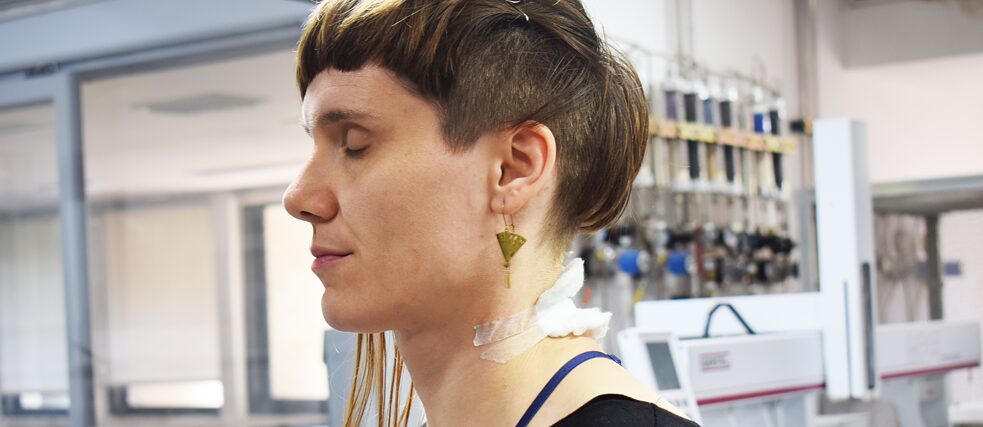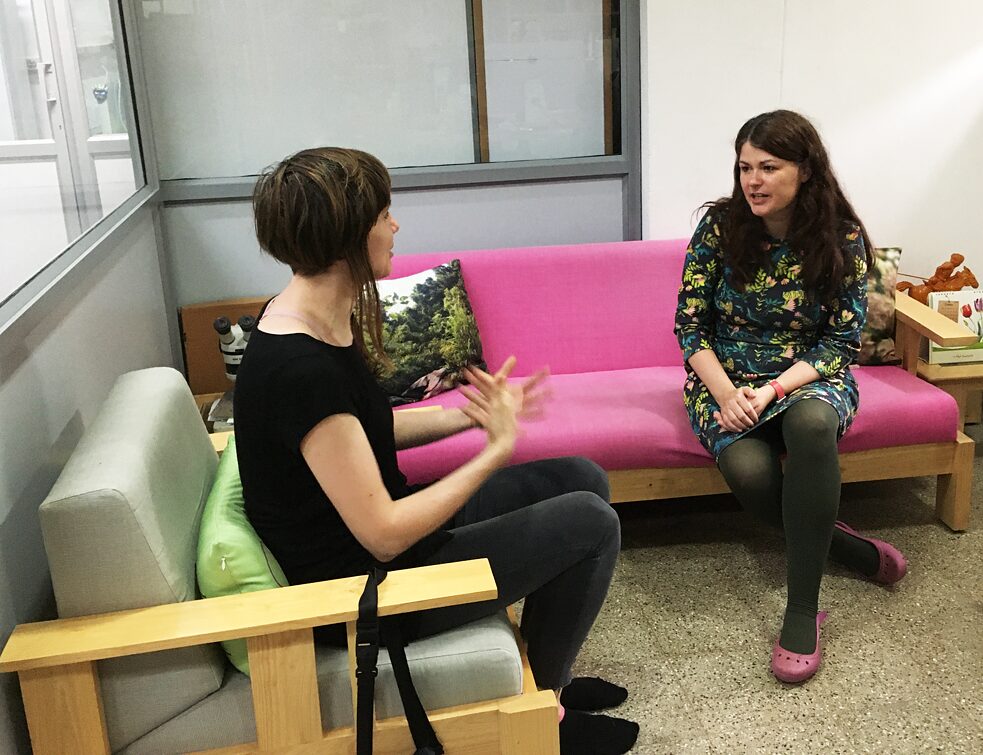The politics of human body scents

My current artistic practice explores the aesthetic potential of body scent through performative olfactory experiments that critically draw from laboratory practices of human olfactory (smell) perception in psychology and neuroscience. With body scent(s) I refer to the entire spectrum of human body odors, as they occur in everyday life. Body scent(s) can be rather natural, or modified by added products such as shower gel, aftershave, essential oils, etc. Overall, all activities (such as working, exercising, food, etc.) have an effect on our body scent(s).
By Lauryn Mannigel
Through my art pieces, I intend to question the stigmatisation of body scents while fostering awareness about the diversity of body scents and the olfactory judgments made about them. In previous projects, such as “Love Sweat Love” (2016), “Eat Me” (2018) and “Smell Feel Match” (2019), I invited participants to smell other’s body scents and asked them to record their felt experience through questionnaires.
By exploring the awareness about our own feelings and potential judgements towards others’ body scents, we undergo a reflective process of making sense of our feelings which enables us to recognise that we have agency over our felt perception towards others’ body scents. My work is thus an attempt to approach our perception in an active manner. In this regard, it follows philosopher Alva Noë’s idea that “[p]erception is not something that happens to us, or in us [but] is something we do” (Noë, A 2004, Action in Perception). Our perception of others is influenced by our understanding and value judgement of our experience of the world. Therefore, I consider body scents, and more so our perception of them, as a political tool.
Smells are powerful because they directly touch our unconscious and make us aware of our unfiltered and uncensored self. In order for us to perceive smells, they need to permeate our bodies, which is an act of visceral penetration. Since we affect each other unconsciously and consciously through the way we smell, body scents have a significant impact on our social life.
When applying to the bangaloREsidency, I had intended to begin exploring ideas related to processes of “othering” by investigating people’s feelings, potential assumptions and judgements about others’ body scents. I understand “othering” as a form of social exclusion based on the premise that a person or group is perceived as "different", and therefore not considered as part of one's own social group.
After my arrival in Bangalore, I set out to gain an understanding of how people in India perceive and construct their world through smell. In this regard, conversations with Suresh Jayaram from 1 Shanthi Road have been crucial. On one hand, I started searching for contemporary academic texts in the cultural history of smell. On the other hand, I was eager to find academic writing on the social perception of human body scent in India in the social sciences, psychology and neuroscience. I found one book — Sandalwood and Carrion: Smell in Indian Religion and Culture (McHugh 2012) — which provides insights into smell in pre-modern South Asia based on Sanskrit texts. Here, comparisons are made between Hindu, Buddhist, and Jain religious practices in relation to smell. The author unveils that urine, dead bodies and excrements stemming from humans, as well as sick people are perceived as foul smelling in pre-modern India. To my surprise, literature on any of the above mentioned topics is very sparse, which leaves a lot of room for future research. In addition, I could not find any contemporary academic texts on the way people perceive each other through their body smell.
At the beginning of my residency, I envisioned to investigate the social perception of people’s scent through creating the olfactory performance experiment entitled “Eat Me #2”. Its precedent is Eat Me #1 which asked participants to imagine a world in which we could experience others by tasting and smelling (retronasal smell) them through our mouth.
Participants were served four snacks and one beverage which alluded to human body scents. The food design was based on interviews at Wageningen University. I asked people if they could imagine eating body scent, and if so, what texture, taste and colour they would ascribe to it.
For "Eat Me #2", I aimed to create a chemical reproduction of aroma compounds of people's everyday life body scent that would be inserted into snacks and drinks. In order to being able to identify an individual’s scent, firstly I would need to collaborate with a scientist who is familiar with the chemical analysis of scent molecules. Secondly, I would require the help of a flavourist so the aroma molecules of the body scent samples can be identified and turned into edible snacks.
Yashas Shetty—a local artist and the brain behind the Art Science (BLR) at Srishti Institute for Art, Design and Technology introduced me to chemical ecologist Dr. Shannon Olsson from the National Center for Biological Sciences (NCBS). After a fascinating conversation with her about olfactory (smell) communication between insects and plants, as well as among humans, Shannon agreed to collaborate with me and lead the chemical analysis of body scents. While discussing the concept of my project, as well as its implementation with her, the following questions arose: From which body parts should participants collect their own body scent and why? Which materials are suitable for the body scent collection? And most importantly whose body scent would I want to collect?
 © Santosh Rajus
As part of my quest to determine whose body scent to explore, I wanted to first get an understanding whether or not assigning people to a caste continues to play a role in Indian society. I thus arranged a meeting with social scientist Sobin George, an Assistant Professor at the Institute for Social and Economic Change. He confirmed that thinking society according to caste remains in people’s minds.
© Santosh Rajus
As part of my quest to determine whose body scent to explore, I wanted to first get an understanding whether or not assigning people to a caste continues to play a role in Indian society. I thus arranged a meeting with social scientist Sobin George, an Assistant Professor at the Institute for Social and Economic Change. He confirmed that thinking society according to caste remains in people’s minds.
Through discussions with women in Bangalore, I learned that female body scents are more stigmatized than male. I responded to these statements by re-focusing my project on the social perception fo women’s body scent. For the near future, I plan to hold conversations with at least five women inquiring about their perception of others’ experience of their own everyday life body scent, as well as their perception of their own smell.
Through multiple attempts to engage in a dialogue about this topic, I quickly noticed that body scent is a big taboo. So far, I have only been able to open conversations with women of the millennial generation. All of them have received higher education. In addition, I would ask my conversational partners to collect their own body scent. I have encountered resistance and a lack of appreciation towards my project idea to present women’s everyday life body scent through snacks. It has mostly been perceived as insensitive, inappropriate, and cannibalistic. I assume that if I was to continue to pursue the idea to make snacks out of women’s body scent, I would drive people away instead of possibly catching their interest in the social perception of women’s smell. As a result, I will reconsider the way I want engage with the public for the final presentation of my project in Bangalore in 2020.
A big thank you to the Goethe-Institute / Max Mueller Bhavan, Meena Vari and Yashas Shetty from the Srishti Institute of Art, Design and Technology, Prof. Shannon Olsson and Srinivas Rao from the NICE Lab at the National Centre for Biological Sciences, 1 Shanthi Road, Prof. Sobin George from the Institute for Social and Economic Change, Blank Noise, the Sandbox Collective, The Courtyard, and all the women in Bangalore with whom I had discussions.
Comments
Comment